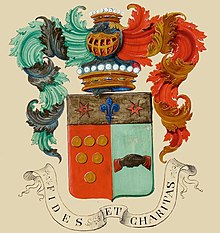
The Camondo family was a prominent Jewish family of financiers and philanthropists who were active in Europe and the Ottoman Empire.

The Camondo family was a prominent Jewish family of financiers and philanthropists who were active in Europe and the Ottoman Empire.
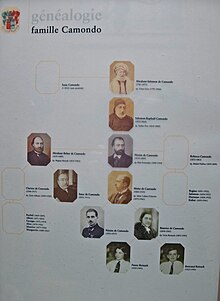
The Camondo family was once part of the Sephardic community in Spain, but the family settled in Venice after the 1492 Spanish decree that ordered the expulsion of all Jews who refused conversion to Catholicism.[ citation needed ] There, some of its members became famous for their scholarship and for the services which they rendered to their adopted country. Following the Austrian takeover of Venice in 1798, members of the Camondo family travelled between Vienna and Istanbul.[ citation needed ] Despite the many restrictions and sumptuary laws imposed on non-Muslims, the family flourished as merchants in the business section at Galata, on the outskirts of the city. They branched into finance in 1802 with the founding of their own bank, named Isaac Camondo & Cie.
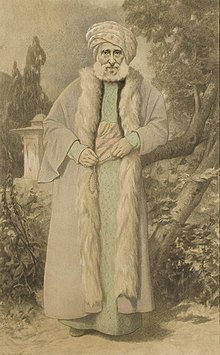
Upon the death of Isaac Camondo in 1831, his brother Abraham Salomon Camondo inherited the bank. He prospered greatly and became the prime banker to the Ottoman Empire until the founding in 1863 of the Imperial Ottoman Bank. In 1865, he relinquished his Austrian citizenship to become a national of the recently created Kingdom of Italy. [1] : 77 In recognition of his contributions and financial assistance to the liberation of Venetia from the Austrian Empire, Abraham Salomon Camondo was ennobled as a hereditary count in 1867 by King Victor Emmanuel II of Italy. The operations of the Camondo bank reflected the transformation of the Jewish community in Constantinople and beyond it, and of the Ottoman financial system. Its ledger of real estate transactions was originally held in Hebrew from 1833 to 1858, then in Italian until 1866, then in French. [1] : 74–75

In 1869, Abraham Salomon Camondo's grandsons Abraham Behor Camondo (1829–1889) and Nissim Camondo (1830–1889) moved to Paris, France, a city the family had previously frequented and where they had established business connections. Abraham Salomon soon followed them there and died in Paris in 1873, but in accordance with his wishes, his remains were returned to Istanbul for burial there in the Jewish cemetery at Hasköy, a neighbourhood on the Golden Horn in Istanbul. His two grandsons remained in Paris and continued to successfully expand the banking business from there until their respective deaths, both in 1889, while keeping a strong link with their native Constantinople.
The next generation, cousins Isaac and Moïse Camondo, both based in Paris, did not display interest in further developing the family business. The banking operations in Constantinople were closed by decision of Isaac Camondo in 1894. [1] : 213
The banking branch of this family is now extinct after the last descendants died – Nissim de Camondo was killed in aerial combat during World War I in 1917, his father Moïse de Camondo died in 1935, then his sister Béatrice de Camondo, along with her two children (Fanny and Bertrand), and her ex-husband Léon Reinach were deported and murdered at Auschwitz around 1944 during World War II. However, there are several living descendants of Isaac Camondo, who was Abraham Salomon's brother and founder of the bank.
Significant members of the family included:
The Musée Nissim de Camondo is located in the 8e arrondissement of Paris at 63 rue de Monceau, where Nissim Camondo lived from 1870 until his death in 1889, then his widow Elise until 1910. The property was then inherited by Moïse de Camondo, who had it torn down and rebuilt to a design by architect René Sergent, inspired by the Petit Trianon in Versailles. [1] : 317 The building and its contents have been preserved in their state at the death of Moïse de Camondo in 1935.
From the late 1870s, Abraham Behar Camondo lived at 61 rue de Monceau, next door to his brother Nissim. He bought the land in 1870 and had a mansion built there to a design by architect Denis-Louis Destors, who also remodeled Nissim's house at number 63. [1] : 148–149 His son Isaac de Camondo sold the estate in 1893 to industrialist Gaston Menier . [1] : 233 In 1946, it became the headquarters of the Pompey Steelworks , which purchased it from the Menier family. Its interior arrangements were demolished during the late 1970s. In 2005, it became the Paris office of Morgan Stanley. [2]
The Camondo bank's offices in Paris were at 31, rue La Fayette. [1] : 170
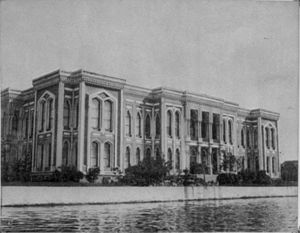
The seaside mansion of the Camondo family, popularly known as the Camondo Palace (Kamondo Sarayı), [3] was built between 1865 and 1869 and designed by architect Sarkis Balyan. [4] [5] It is located on the northern shore of the Golden Horn, within the Kasımpaşa quarter of the Beyoğlu district, to the west of Galata (Karaköy). It later became the headquarters of the Ministry of the Navy (Bahriye Nezareti) [4] [5] during the late Ottoman period, and is currently used by the Turkish Navy as the headquarters of the Northern Sea Area Command (Kuzey Deniz Saha Komutanlığı).) [3] [4] [5]
The Camondo family also built two historic apartment buildings in Galata, both of which are named Kamondo Apartmanı. The older one is located at Serdar-ı Ekrem Street near Galata Tower and was built between 1861 and 1868, [3] while the newer one is located at the corner between Felek Street and Hacı Ali Street and was built in 1881; [6] it was later converted into the upscale Galata Residence Hotel. [7]

The Camondo Stairs (or Camondo Steps), a famous pedestrian stairway designed with a unique mix of the Neo-Baroque and early Art Nouveau styles, were built in circa 1870–1880 by Abraham Salomon Camondo. The stairway forms the part of Bereketzade Medresesi Sokağı (Bereketzade Madrasa Street) that connects Bankalar Caddesi (Banks Street) with Banker Sokak (Banker Street) in the Galata (Karaköy) quarter of Istanbul. [8]

Galata is the former name of the Karaköy neighbourhood in Istanbul, which is located at the northern shore of the Golden Horn. The district is connected to the historic Fatih district by several bridges that cross the Golden Horn, most notably the Galata Bridge. The medieval citadel of Galata was a colony of the Republic of Genoa between 1273 and 1453. The famous Galata Tower was built by the Genoese in 1348 at the northernmost and highest point of the citadel. Galata is now a quarter within the district of Beyoğlu in Istanbul.

Beyoğlu is a municipality and district of Istanbul Province, Turkey. Its area is 9 km2, and its population is 225,920 (2022). It is on the European side of Istanbul, Turkey, separated from the old city by the Golden Horn. It was known as the region of Pera surrounding the ancient coastal town Galata which faced Constantinople across the Horn. Beyoğlu continued to be named Pera during the Middle Ages and, in western languages, into the early 20th century.

Count Abraham Salomon Camondo was a Jewish Ottoman-Italian financier and philanthropist, and the patriarch of the Camondo family.

Nissim de Camondo was a French military officer and a member of the prominent Camondo family.

Louise Béatrice Reinach was a French socialite and a Holocaust victim.

The Ottoman Bank, known from 1863 to 1925 as the Imperial Ottoman Bank and correspondingly referred to by its French acronym BIO, was a bank that played a major role in the financial history of the Ottoman Empire. By the early 20th century, it was the dominant bank in the Ottoman Empire, and one of the largest in the world.

Count Moïse de Camondo was an Ottoman Empire-born French banker and art collector. He was a member of the prominent Camondo family.

The Musée Nissim de Camondo is a historic house museum of French decorative arts located in the Hôtel Moïse de Camondo at 63, rue de Monceau, on the edge of Parc Monceau in the 8th arrondissement of Paris, France. The nearest Paris Métro stops are Villiers and Monceau on Line 2.

Karaköy, the modern name for the old Galata, is a commercial quarter in the Beyoğlu district of Istanbul, Turkey, located at the northern part of the Golden Horn mouth on the European side of Bosphorus.

Haim Palachi was a Jewish-Turkish chief rabbi of Smyrna (İzmir) and author in Ladino and Hebrew. His titles included Hakham Bashi and Gaon. He was the father of grand rabbis Abraham Palacci and Isaac Palacci and rabbi Joseph Palacci. He was a member of the Pallache family.
René Sergent was a French architect.

The architecture of Istanbul describes a large mixture of structures which reflect the many influences that have made an indelible mark in all districts of the city. The ancient part of the city is still partially surrounded by the Walls of Constantinople, erected in the 5th century by Emperor Theodosius II to protect the city from invasion. The architecture inside the city proper contains buildings and structures which came from Byzantine, Genoese, Ottoman, and modern Turkish sources. The city has many architecturally significant entities. Throughout its long history, Istanbul has acquired a reputation for being a cultural and ethnic melting pot. As a result, there are many historical mosques, churches, synagogues, palaces, castles and towers to visit in the city.

Bankalar Caddesi, also known as Voyvoda Caddesi, in the historic Galata quarter of the Beyoğlu (Pera) district in Istanbul, Turkey, was the financial centre of the late Ottoman Empire. It strikes out west from busy Kemeraltı Caddesi in Karaköy and segues into Okçu Musa Caddesi which leads up to Şişhane and Tepebaşı in Beyoğlu.

Kasımpaşa is a working-class neighbourhood on the northern shore of the Golden Horn within the Beyoğlu district of Istanbul, Turkey, on the European side of the city. Once best known for its naval bases and shipyards, it is a rapidly evolving area, likely to be greatly changed by the Haliçport-Tersane Istanbul projects taking shape along its shoreline in 2022.
The Bischoffsheim family is a family of German-Belgian Jewish descent known for their success in banking. It can be traced back to Raphaël Nathan Bischoffsheim, an army contractor native of Tauberbischofsheim, in the Electorate of Mainz. The family was particularly interwoven with the Goldschmidt family of Frankfurt am Main; the two families intermarried over the generations and jointly managed Bischoffsheim, Goldschmidt & Cie bank, which they eventually merged into Banque de Crédit et de Dépôt des Pays-Bas in 1863.

"Pallache" – also de Palacio(s), Palache, Palaçi, Palachi,Palatsi, Palacci, Palaggi, al-Fallashi, and many other variations (documented below) – is the surname of a prominent, Ladino-speaking, Sephardic Jewish family from the Iberian Peninsula, who spread mostly through the Mediterranean after the Alhambra Decree of March 31, 1492, and related events.

The Camondo Stairs are 19th century stairs on Bankalar Caddesi in the Galata quarter of the Pera district in Istanbul, Turkey.

Kuledibi is a quarter of İstanbul's Beyoğlu district. The term is generally used to describe the surrounding areas around the Galata Tower. The region extends to the streets parallel to Voyvoda Street in the south, Okçu Musa Street in the west, Yüksek Kaldırım Street in the east, Tımarcı Street and Şahkulu Street in the north.

The Portrait of Irène Cahen d’Anvers, or The Little Girl with the Blue Ribbon or Little Irène, is an oil painting by French Impressionist artist Pierre-Auguste Renoir.
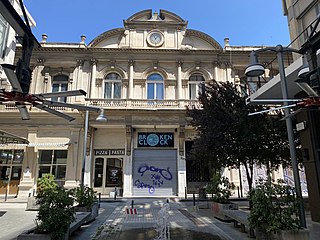
The Bank of Salonica was a regional bank headquartered in Thessaloniki and Istanbul. Created in 1886 under the initial leadership of the Salonica Jewish Allatini family with Austrian, Hungarian and French banking partners, it contributed to the development of the Eastern Mediterranean and Southern Balkans during the late Ottoman Empire. In the Interwar period its activity was mainly focused on Northern Greece, where it operated until the German occupation, and Turkey, where it kept operating until 2001, albeit under different names after 1969. Its preserved headquarters buildings are landmarks, respectively, of Valaoritou Street, a significant thoroughfare of downtown Thessaloniki, and of Bankalar Caddesi in the Karaköy neighborhood of Istanbul.